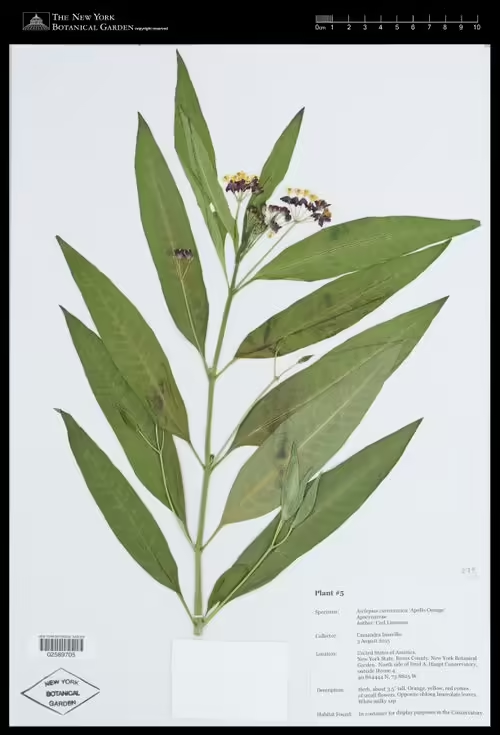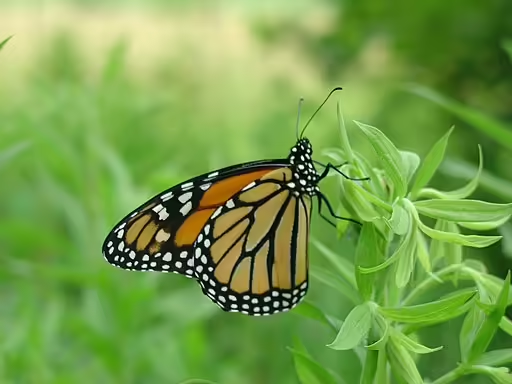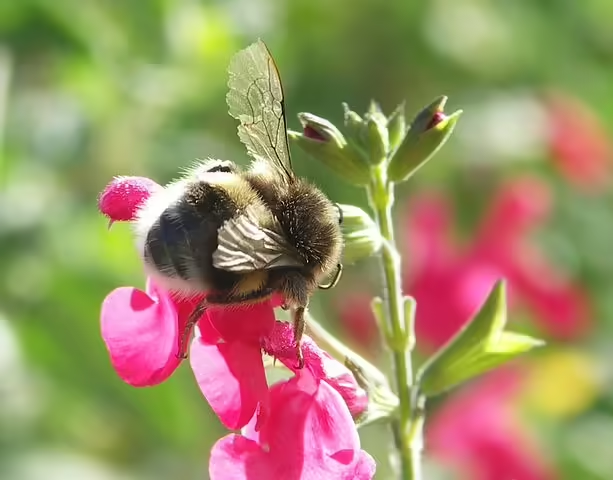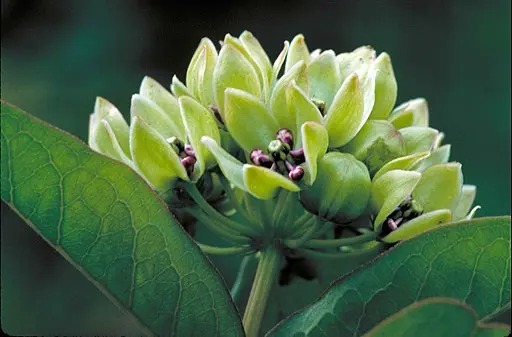Table of Contents for Tropical Milkweed (Asclepias curassavica)
Tropical Milkweed (Asclepias curassavica) is a herbaceous perennial that is native to the western United States. This plant is a host to the Queen (Danaus gilippus) and Monarch (Danaus plexippus) butterflies. Growing from 1 to 3 feet tall, this species has orange to red flowers and yellow hoods that bloom from June to October. It is hardy in zones 8-11.
Taxonomy and Naming of Tropical Milkweed (Asclepias curassavica)

Taxonomy
Pallid milkweed (Asclepias cryptoceras) was named and described by Carl von Linnaeus in Species Plantarum in 1753. The species has kept this name since and is a member of the Dogbane Family (Apocynaceae).
Meaning of the Scientific and Common Names
Scientific Name
The genus name, Asclepias, is named for the Greek god of healing, Asklepios (Flora of Wisconsin). The species name, currasavica, describes the place in the Caribbean where it comes from.
Common Name and Alternative Names
The common name describes the tropical nature of the plant, which grows mostly in tropical regions. Other common names include scarlet milkweed, blood flower, Indian root, sunset flower, Mexican butterfly weed, and swallow wort. Another lesser encountered common name is Bastard Ipecacuanha (Hamilton 1847). In the Philippines, this plant has numerous local names, which are too many to name here (Brown 1919).
Physical Description of Tropical Milkweed (Asclepias curassavica)

Description
- Plant Type: This plant is a herbaceous perennial that is sometimes grown as an annual.
- Height: 2 to 3 feet
- Stem: pilose when young, glabrate with age (Woodson 1954)
- Leaves: The leaves are opposite, simple, entire, and lanceolate in shape (Woodson 1954). The leaves are 3 to 6 inches in length and 1 to 3 inches wide. The leaves are nearly evergreen in the tropics (Martin and Gurrea 1988).
- Flower color: orange, yellow, or red
- Blooming period: This plant blooms from June to October. It can flower longer in more tropical conditions (Martin and Gurrea 1988).
- Fruiting type and period: This plant has follicles that mature in the late summer and fall.
Range of Tropical Milkweed (Asclepias curassavica) in the United States and Canada

This milkweed species is adventive in the states of California, Florida, Hawaii, Louisiana, Tennessee, and Texas. It is widespread throughout the world and is thought to be native originally from either the Caribbean or South America (Woodson 1954).
Habitat

This species grows in places of disturbance such as roadsides, railroads, and fields. This probably helps it spread easily in places where it is planted.
Hosted Insects

This species is a host for the Monarch Butterfly (Danaus plexippus), the Queen Butterfly (Danaus gilippus), African Queen Butterfly (Danaus chrysippus) (Tennent 1994 and Van der Poorten 2011), the Common Tiger Butterfly (Danaus genutia) (Van Hook and Zalucki 1991), the Australian Crow Butterfly (Euploea core corinna) (Ackery and Vane-Wright 1984), and southern monarch (Danaus erippus) (Walker 1914). This species in particular was selected by monarch butterflies in Florida (Malcolm and Brower 1986) and in Texas (Calvert 1999) in studies looking at host selection and monarchs raised on tropical milkweed grew better overall (Erickson 1973).
Other Supported Wildlife

This species is a nectar source to other butterflies, skippers, bees, and wasps during the growing season.
Frequently Asked Questions about Tropical Milkweed (Asclepias curassavica)
Is this plant poisonous?
Like other milkweeds, it has cardiac glycosides (cardenolides) and is considered to be poisonous with ingestion. This species in general has more cardenolide concentration than other species of milkweed (Malcolm and Brower 1986).
Does this plant have any ethnobotanical uses?
The Native American Ethobotanical Database does not mention this species in particular, but milkweeds in general have been used for pain relief, fibers, and foods. In Australia this plant has been used as a fish poison by the aborigines (Hamlyn-Harris 1916). In the Philippines the seed pappus has been used to stuff pillows (Brown 1919).
How is this plant distinguished from other milkweeds?
This species is most similar to aquatic milkweed (Asclepias perennis), but aquatic milkweed has white, pink to rose flowers, versus the very distinctive orange-red flowers of this species (Weakley 2022). In the tropics, this species is similar to the Caribbean milkweed (Asclepias nivea), but differs in that Caribbean milkweed has linear-lanceolate leaves, whereas tropical milkweed has ovate-lanceolate leaves (Hamilton 1847). Perhaps the most distinctive aspect of the plant is the yellow centers, which is different from most other milkweeds.
Is this plant invasive?
This plant has spread widely from its native range and is considered to be invasive (Cabi Digital Library).
Any other interesting facts about this milkweed?
This milkweed may have made it possible for the Monarch butterfly to survive on the island of Bermuda and on the Hawaiian Islands. The butterflies were in these places before this plant but only survived once this plant was introduced (Brower 1995). This plant may also be responsible for the survival of an introduced population of Monarch butterflies in Madeira (Showler 2001).
Anything else about this plant?
This plant is known to harbor a parasite (Ophryocystis elektroscirrha), which can harm monarch butterflies (The Spruce and NC Extension Gardener).
Gardening with Tropical Milkweed (Asclepias curassavica)

Hardiness
This species is hardy in zones 8-11 (perennial) or 4-8 (annual) (University of Florida Extension). If your garden is within these zones and you have the right growing conditions (soil, moisture and exposure), you may well be able to grow this plant. However, if planted outside of its range, the hosted species may not recognize the plant or be harmed by ingesting a different species with an unfamiliar chemical composition.
Optimal Conditions
This species grows best in places it can receive full sun or partial shade and has dry and/or rocky sandy soils that are well-drained.
Cultivars
Tropical milkweed is highly cultivated around the world and has numerous cultivars. Some of these include:
- ‘Apollo Orange’: a cultivar with orange flowers
- ‘Apollo Yellow’: a cultivar with yellow flowers
- ‘Gay Butterflies’: a cultivar with red flowers and yellow centers
- ‘Jamaica’: a cultivar with bright orange flowers and yellow centers
- ‘Red Butterfly’: a cultivar with dark red flowers
- ‘Silky Deep Red’: a cultivar with dark red flowers
- ‘Silky Gold’: a cultivar with yellow flowers and red centers
- ‘Soulmate’: a cultivar with orange flowers and yellow centers
- ‘Tuberosa’: a cultivar with orange flowers and yellow centers
Planting Pallid Milkweed
The seeds of this species, require a period of cold stratification in order to germinate. Because of this it is best to plant the seeds in the fall or early winter. If you get your seeds commercially, make sure that they have been cold stratified.
References
- Ackery, P.R. and R.I. Vane-Wright. 1984. Milkweed Butterflies, their cladistics and biology. British Museum (Natural History), London.
- Brower, Lincoln P. 1995. Understanding and Misunderstanding the Migration of the Monarch Butterfly (Nymphalidae) in North America: 1857-1995. Journal of the Lepidopterists’ Society 49: 304-385.
- Brown, William Henry. 1919. Philippine Fiber Plants. (Manila: Bureau of Printing).
- Calvert, William H. 1999. Patterns in the spatial and temporal use of Texas milkweeds (Asclepiadaceae) by the Monarch Butterfly (Danaus plexippus L.) during fall, 1996.
- Erickson, James M. 1973. The Utilization of Various Asclepias species by larvae of the Monarch Butterfly, Danaus plexippus. Psyche, A Journal of Entomology 80: 230-244.
- Hamilton, W. 1847. Art. V. – On the Properties of the Asclepias curassavica, or Bastard Ipecacuanha. American Journal of Pharmacy 13: 19-25.
- Hamlyn-Harris, R. 1916. On Fish Poisoning and Poisons Employed among the Aborigines of Queensland – Plates IV and V and One Text-figure. Memoirs of the Queensland Museum 5: 1-22.
- Malcolm, S.B. and Lincoln P. Brower. 1986. Selective Oviposition by Monarch Butterflies Danaus plexippus L. in a mixed stand of Asclepias curassavica L. and Asclepias incarnata L. in South Florida USA. Journal of the Lepidopterists Society 40: 255-263.
- Martin, J. and P. Gurrea. 1988. Establishment of a population of Danaus plexippus (Linnaeus, 1758) (Lep. Danaidae) in Southwest Europe. Entomologist’s Record and Journal of Variation 100: 163-168.
- Showler, Alan. 2001. The possible introduction to Madeira of the Monarch butterfly, Danaus plexippus (L.) (Lepidoptera). British Journal of Entomology and Natural History. 14 (1): 43-44.
- Tennent, John W. 1994. Danaus chrysippus Linnaeus, 1758; a review of records and present status in the Maghreb countries of Morocco, Algeria, and Tunisia (Lepidoptera, Danainae). Nota Lepidopterologica 17: 201-216.
- Van der Poorten, D. 2011. New and revised descriptions of immature stages of some butterflies in Sri Lanka and their larval food plants (Lepidoptera: Nymphalidae), Part 1: Sub-family Danainae. Journal of Research on the Lepidoptera 44: 1-16.
- Van Hook, Tonya, and Myron P. Zalucki. 1991. Oviposition by Danaus plexippus (Nymphalidae: Danainae) on Asclepias viridis in northern Florida. Journal of the Lepidopterists Society 45: 215-221.
- Walker, James John. 1914. The geographical distribution of Danaida plexippus L. (Danais archippus, F) with especial reference to its recent migration. Entomologist’s Monthly Magazine 50: 181-193.
- Weakley, A.S., and Southeastern Flora Team 2022. Flora of the southeastern United States. University of North Carolina Herbarium, North Carolina Botanical Garden.
- Woodson, Robert E. 1954. The North American Species of Asclepias L. Annals of the Missouri Botanical Garden 41: 1-211.


